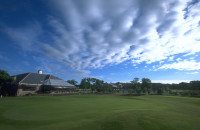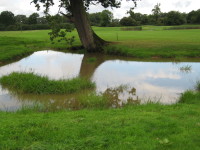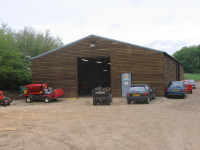September Golf Diary 2009

September is a popular month for both club golfers and societies. It is the last month of the year when day time temperatures remain warm and golf can still be played until early evening. Recent Septembers have tended to be relatively dry although the long term average suggests otherwise.
Growth has a slight surge before slowing down as the onset of winter looms ever closer and, as such, mowing may be required on a greater frequency than during August. Since the golfing calendar is likely to be busy, the needs of the turf have to be balanced against the economic requirements of the club.
That, to some, extent is why it is better to plan major work on the greens in August when it tends to be quieter as opposed to September. With increasing levels of dampness at night and during the early morning when temperatures are cooler, the risk from disease attack increases and this is the key issue for Turf Managers at this time of year.
Greens
 Major work on the greens tends to be completed before or after September, depending upon individual club and course requirements. That said, the focus needs to remain on producing dry, firm and consistent putting surfaces of reasonable pace while avoiding any turf stress which will increase the risk from disease such as Anthracnose and Fusarium.
Major work on the greens tends to be completed before or after September, depending upon individual club and course requirements. That said, the focus needs to remain on producing dry, firm and consistent putting surfaces of reasonable pace while avoiding any turf stress which will increase the risk from disease such as Anthracnose and Fusarium.
September is also the last month where overseeding can be completed with any guarantee of success, since frosts are unlikely and soil temperatures remain well above the required growing temperature.
Mowing should remain at summer height at the start of the month but likely to rise by 0.5mm before the month concludes. Towards the end of the month, the frequency of mowing may be reduced in favour of rolling but grooming or verti-cutting should be relatively minimal to avoid mechanical stress, especially if overseeding has recently been completed.
Aeration needs to continue since it is essential that air is maximised into the rootzone. However, surface disruption must be minimal, therefore a combination of needle, micro and star tining will meet the needs of both turf and golfer.
Should dry weather persist then limit the use of automatic irrigation to a minimum. Better for water to be applied manually and targeted where it is needed although staffing levels may not be sufficient in number for this to occur. If necessary, continue with the use of wetting agents if dry patch or drought stress remains evident.
 Since growth is likely to be constant in September, the need to supply the turf with sufficient nutrients is also necessary, albeit in very small quantities. Here, a balance needs to be retained in supplying only what the turf requires otherwise too much nutrient will lead to weak and succulent growth that is prone to wear and disease. Too little and the turf remains weak and impoverished, unable to deal with same stresses as mentioned before.
Since growth is likely to be constant in September, the need to supply the turf with sufficient nutrients is also necessary, albeit in very small quantities. Here, a balance needs to be retained in supplying only what the turf requires otherwise too much nutrient will lead to weak and succulent growth that is prone to wear and disease. Too little and the turf remains weak and impoverished, unable to deal with same stresses as mentioned before.
Applications should include both Potassium and Iron at this time of year along with Silicon to help improve the strength of the plant cell wall. The addition of phosphite will also act as a mild fungicide and these type of tank mixes along with seaweed and humic acids should be part of the overall turf nutrient strategy. Surface dampness will steadily increase as cooler and calm conditions through the night will lead to heavy dew forming.
This is the danger period for disease to develop therefore the duration of surface wetness needs to be curtailed by both manual means and by using a penetrant or dew removal product.
Tees
Mowing is likely to remain at twice per week unless conditions dictate otherwise. Height of Cut (HOC) should remain at around 12mm for most courses but should be raised for non irrigated tees if dry weather continues and the turf is looking drought stressed.
Apply a wetting agent if necessary but best to solid tine the teeing areas in advance. Playing levels are likely to increase due to the impact of society play and competitions, therefore daily movement of tee markers and regular divoting will be the norm to maintain good surface quality and presentation.
Fertiliser requirements will be based purely upon the needs of the turf and largely dependent on when the tees were last fed. The standard requirements of low N and high K should continue, along with a Plant Growth Regulator to maintain good turf density. If overseeding is planned, then aim to scarify in advance in order to create the best possible environment for the young seedlings to germinate. Good seed to soil contact at about 4 to 6mm depth will give the best results and, if possible, cover with topdressing for added protection.
Surrounds
The maintenance of collars should be similar to that of the greens, apart from the obvious difference in height and frequency of cut. Potential problems to be aware of are from drought stress and wear from either equipment turning or from golfers where 'bottlenecks' occur. Aerify before applying wetting agent for the former and introduce traffic control measures re the latter where possible.
This is also a good time for overseeding any weak collars but, again, the emphasis needs to be on good preparation of the surfaces for germination to be successful. The main area of greens surrounds require little maintenance other than regular mowing at around 35mm. Should these areas be lacking in sufficient vigour then feed with a general compound containing a small amount of N. Autumn/winter slow release feeds work well for these areas, but for most courses this will be unnecessary.
Fairways
Unless conditions are extremely dry, definition should be good since growth will be sufficient to give a good contrast between semi-rough and fairway. Mowing should still be twice per week at between 14mm and 17mm unless on links or heathland courses where mowing heights are likely to be less. In September, 'dewy' mornings may become the norm therefore the avoidance of wet mowing is paramount for course presentation.
Either delay mowing until the grass is dry but, if not, then brush clear ahead of mowing using a wide multi-brush or similar. Another alternative is to follow on behind with a tractor mounted blower, but this requires another person which may or may not be feasible.
Dragging a hose pipe along the fairway between two run-about vehicles to disperse early morning dew can also prove effective. As per 'August' requirements, there may be a desire to apply a foliar feed to enhance colour and presentation, therefore the previous recommended application of urea and possibly iron will again suffice.
 Divot filling is an on-going requirement but time consuming; therefore the solution may be 'divoting parties' with the enticement of a pizza and beer to reward the member's endeavours. If fairways are fibrous and prone to drying out, then scarifying to a depth of between 15mm to 25mm with powered reels such as Veemos will help to get rid of a lot of material. However, this will need to be collected with a sweeper/collector unless the amount is small. This being the case then a blower may suffice.
Divot filling is an on-going requirement but time consuming; therefore the solution may be 'divoting parties' with the enticement of a pizza and beer to reward the member's endeavours. If fairways are fibrous and prone to drying out, then scarifying to a depth of between 15mm to 25mm with powered reels such as Veemos will help to get rid of a lot of material. However, this will need to be collected with a sweeper/collector unless the amount is small. This being the case then a blower may suffice.
Ground conditions need to be moist underneath and dry on the surface for this operation to have maximum effect, therefore timing and ground conditions are the all important consideration.
Roughs
Limited maintenance of rough areas will be required in September apart from regular mowing; the frequency of this being reduced towards the ends of the month. Management of deep or out of play rough should continue when time permits with a view to 'cleaning' and 'topping' all areas before the season draws to a close. Early in the month it may still be possible to target weed control of docks and thistle although the success rate may not be as high as when tackled in the summer months.
Bunkers
Ongoing maintenance will include regular trimming and edging plus blowing sand clear if grass faced bunkers are present. Stone picking and weed control should form part of the regular programme along with periodic checks on sand depth. Unless wash-outs have occurred, bunker maintenance should be fairly consistent throughout the growing season. A good supply of rakes is essential and any broken or damaged ones should be replaced as soon as possible.
Other
Lakes/Ponds/Ditches: With cooler temperatures and shorter daylight hours, any algae bloom should be in decline but, if not, then the same methods of control as listed in the August golf diary will apply.
Ditch lines should continue to be kept trimmed and adequately marked with appropriate hazard posts. This is probably the last opportunity to apply glyphosate to any banks, therefore best to make sure that all areas are treated where necessary.

|

|
Where ponds have become overgrown with bullrushes, September is a good time to hire in an excavator to clear out as much as possible while ground conditions are firm and pond/lake levels likely to be low. A skilled operator should be used for this operation and to always work from a level base.
Paths: Again, using glyphosate for weed control to paths, steps and around ball washers, bins, signage etc needs to be completed by the end of this month. Any pot-holes should be filled, levelled and rolled before the onset of winter and while these areas remain dry.
Trees: Remove any overhanging branches that pose a nuisance to both golfers and equipment, and remove any unwanted growth from near the base. If grass growth is starting to be a problem again around the base, then apply glyphosate while good control can still be established.
Watchlist:
Disease: During September, the main threat of disease is likely to come from Anthracnose Foliar Blight and Fusarium. Details for prevention and treatment of the former has been listed in previous monthly articles but it is worth re-iterating that this disease is a sign that the turf is under stress and chemical control alone is not the answer. With regards to Fusarium, this is the most common disease that affects turf in the UK and is largely a result of environmental and cultural conditions favouring this disease.
These include surface wetness, shade, lack of air movement, thatch, compaction, shallow rooting, poor oxygen supply within the rootzone, poor drainage, over fertilising and so on. In summary, it is all about managing turf in a more healthy condition. Where greens are prone to this disease then chemical control must be part of an IPM strategy.
Preventative action will include applying a mix of products containing the chemicals Tebuconazole (systemic) and Prochloraz (Translaminar) along with a Strobilurin, tank mixed with an adjuvant for better product performance. Other alternatives are available but combining products with a different mode of action and relevant to soil temperature will give the best form of control.
Pests: The risk of turf damage from any pests during September is relatively low. If ground conditions remain wet, then earthworms may start to pose problems on heavier or alkaline soils, otherwise this should be a trouble-free month.
 Turf Disorders: Drought stress and dry patch may continue to give cause for concern if there is a lack of rain and dry, windy conditions prevail. Any water applied to greens or tees at this time of year should be minimal and really confined to the areas affected. See previous 'Greens' article for dry patch control.
Turf Disorders: Drought stress and dry patch may continue to give cause for concern if there is a lack of rain and dry, windy conditions prevail. Any water applied to greens or tees at this time of year should be minimal and really confined to the areas affected. See previous 'Greens' article for dry patch control.
Equipment:
Servicing and checking of equipment to continue, with the emphasis still being placed on hydraulic pipes, valves, safety switches and cutting units. Sharpness of cylinder reels needs to be checked since cutting with blunt blades can add to the risk of disease pressure.
Irrigation:
By September, the system should be in 'wind-down' mode unless conditions dictate otherwise. If the system is not being used, then this is an ideal time to 'catch-up' on any repairs to leaking valves, pipes, cable breaks and so on while there is an opportunity to do so and while conditions are still warm during the daytime.
Compound:
As in the previous month, take any opportunity to tidy up external areas of the compound and to check on supplies of sands, gravel, fungicide and wormicide which are likely to be required over the coming months.
Laurence Pithie MG
Turf Master One Ltd
www.turfmasterone.co.uk
